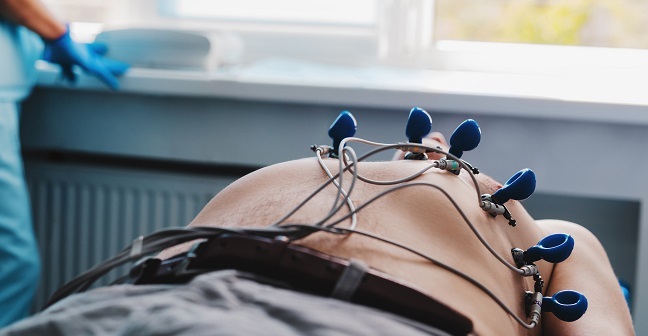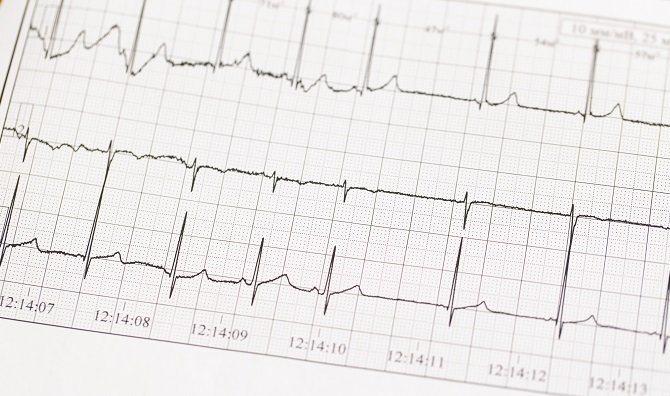
 Data Structure
Data Structure Networking
Networking RDBMS
RDBMS Operating System
Operating System Java
Java MS Excel
MS Excel iOS
iOS HTML
HTML CSS
CSS Android
Android Python
Python C Programming
C Programming C++
C++ C#
C# MongoDB
MongoDB MySQL
MySQL Javascript
Javascript PHP
PHP
- Selected Reading
- UPSC IAS Exams Notes
- Developer's Best Practices
- Questions and Answers
- Effective Resume Writing
- HR Interview Questions
- Computer Glossary
- Who is Who
What is the full form of ECG?
Introduction
Electrocardiogram (ECG) is a non-invasive signal. The time varying bio signals were measured by techniques such as invasive signal and non-invasive signal. The ECG recordings are monitored by some types of signal processing algorithms automatically.

Electrodes are placed on the chest arms and legs and they measure the electrical response of the heart muscles. The other end of the electrodes is connected to the monitor by lead wires. The electrical response of the heart is then analysed, monitored and printed.
Definition
The first electrocardiogram was first developed by the Dutch Physiologist Willem Einthoven in 1903. Human heart is able to produce electric impulse on its own. The electric current that produced due to this electric impulse passed to the skin through the body. This electrical activity is measured by ECG. ECG graphically represents the electric current that is produced by the heart muscles during heartbeat. The contraction of atria and ventricle causes the heartbeat. By using leads at different positions on the chest, arms and legs that are connected to the ECG machine, heart's activity is monitored.
Types of ECG
There are many types of ECG used by doctors for various purposes.
CPET
CPET is called a cardiopulmonary exercise test. Cardiopulmonary system is evaluated using CPET. It is used to identify pulmonary diseases.
Exercise ECG or stress test
It shows the measurement of heart's activity while the person is in stress or doing exercise. This test was conducted to detect safety levels of doing exercise and coronary artery diseases.
Holter Monitor
This type of ECG is used when there is a need for continuous monitoring of the patient for 24 hours and long.
Resting ECG
It is called a resting 12 lead ECG. This shows the normal electrical activity of the heart. It was taken at a resting and relaxed position.
Signal-averaged ECG
This gives more details of heart muscles. This was done by taking multiple ECG tracings and interpreting them.
Purpose
There are many purposes that a doctor suggests to take ECG. They are
To know the root cause of the heart pain.
To find the irregularity in heartbeat.
To monitor the working of implanted pacemakers.
For the evaluation of heart related diseases like breathing problems, fainting tiredness etc.
To check for the heart's activity before and after surgery and continuous monitoring during surgery.
To monitor the working of medications.
Verification of the thickness of the heart wall.
Procedure
The steps that are done during taking ECG are
The patient is made to lay down straight for taking the test.
There are 12 electrodes in the ECG. These sticky electrodes were connected at different positions on the arms, limbs and chest.
The other end of the electrodes will be connected to the ECG machine in which the electrical activity of the heart muscles is detected.
The ECG machine detects even small changes in the electrical changes and converts that into wave patterns for each cycle.
Analysis of the heart functions were done by using the pattern derived by the ECG machine.
ECG leads
There are 12 electrodes or leads used in the ECG machine. The combination of the information of all leads gives the complete pattern of ECG. They are limb leads, augmented limb leads and chest leads.
Limb leads
Three limb leads are connected to the left arm(LA), right arm(RM) and left leg(LL). Lim lead I, II, and III denotes the electrical differences from LA to RA, RA to LL and LA to LL respectively.
Augmented limb leads
Augmented limb leads are aVR, aVL and aVF which are calculated from the limb leads. These leads combined with limb leads and provide information of the view of the frontal plane of the heart.
Chest leads
There are six chest leads such as V1, V2, V3, V4, V5 and V6. They were placed at different positions to get the electrical activity.
Interpretation
From the information of the 12 leads the wave pattern of the cardiac cycle is recorded and printed. It is the graphical representation voltage versus time. It was divided into many segments

Atrial depolarization is represented by the P wave. Its normal range is ≪0.08sec.
PR interval denotes the time of travelling of impulse from SA node to AV node. Its range is 0.12 - 0.2 s.
Ventricular depolarization is represented by the QRS complex. Its range is 0.08 - 0.1s.
The T wave represents the ventricular repolarization. Its range is 0.16s.
Abnormalities
Wave parts |
Analysis |
|---|---|
No P wave |
Atrial fibrillation |
Wide QRX |
Ventricular depolarization |
Prolonged PR interval |
Ist degree AV block |
Negative T wave |
Depolarization delay |
Elevated ST |
Block in coronary artery |
Conclusion
ECG or EKG is called an electrocardiogram which measures the electrical activity of the muscles of the heart. It is used to monitor and identify the abnormalities in the heart. During this test 12 electrodes were placed on the human body at different positions and the electrical response of the muscles were recorded and printed in a graphical manner. From this the defect in the heart can be identified.
FAQs
What are the factors that may affect the result of ECG?
The factors that may affect ECG result are
Movement while taking the test.
Smoking or exercise before having the test.
Pregnancy
Due to some medicines
Electrolyte imbalance in the blood.
What is known as a cardiac cycle?
Cardiac cycle denotes the alternate sequence of contraction and relaxation of the heart muscles in order to circulate blood throughout the body.
What are systole and diastole phases?
There are two phases in the cardiac cycle called diastole and systole. During the diastolic stage the heart is in a relaxed position and blood from other parts of the body fills the heart by means of the veins. During the systolic stage the heart contracts and the blood inside the heart is distributed to all parts through arteries. This complete cycle is called the cardiac cycle.

